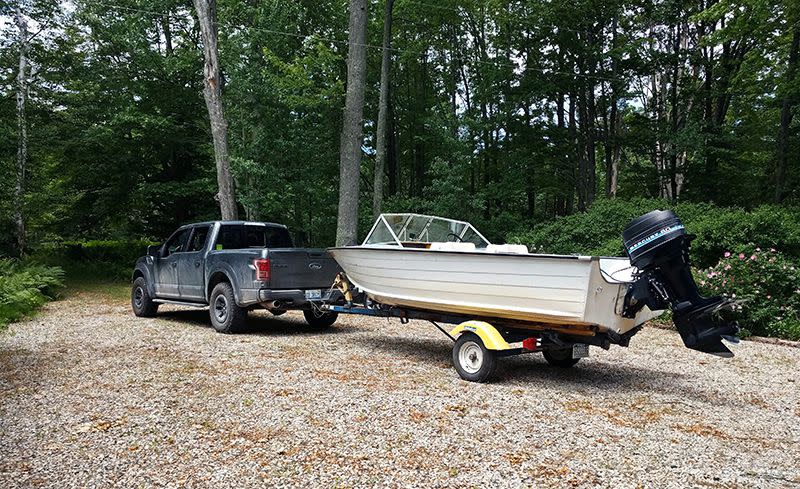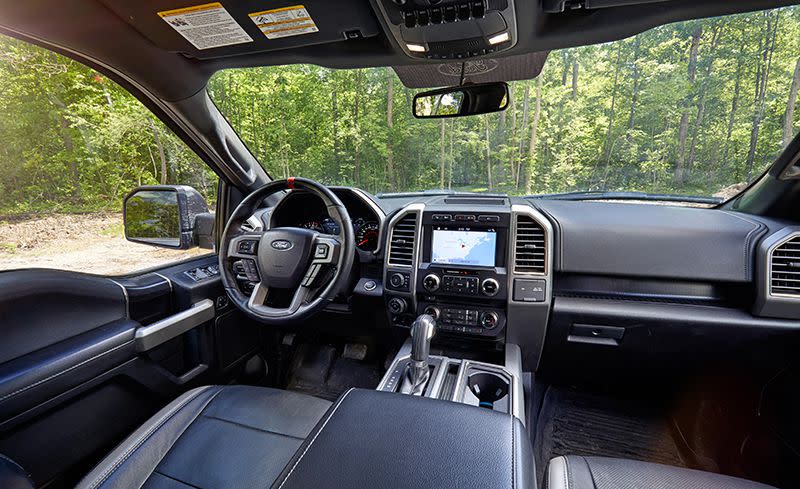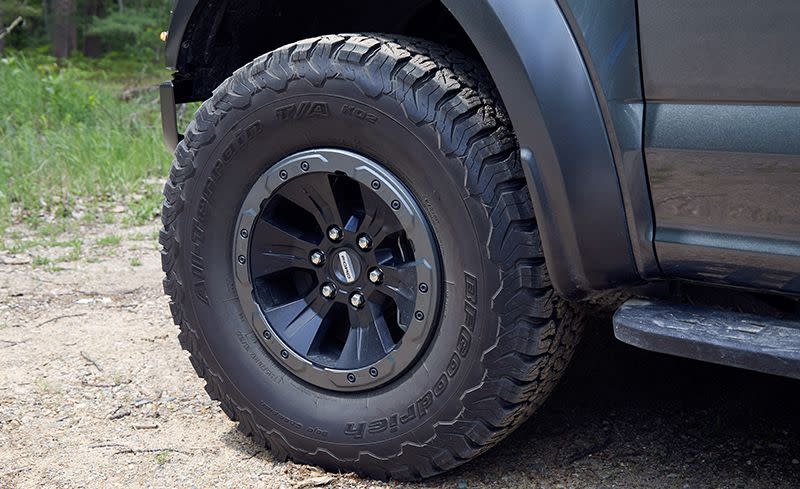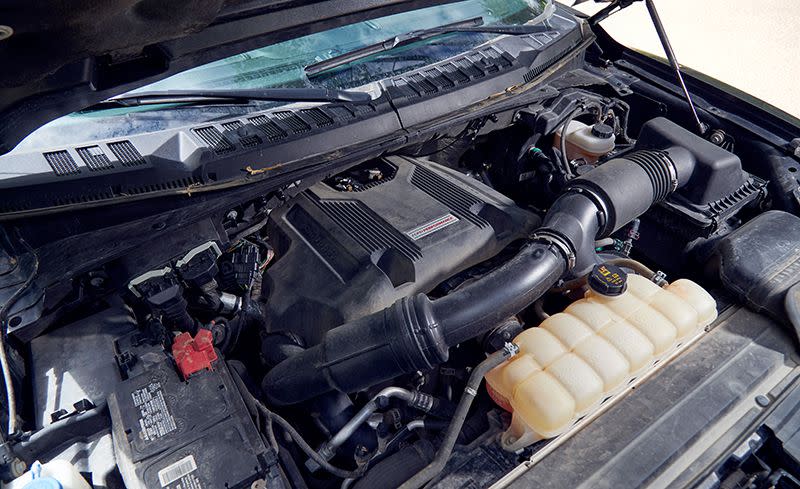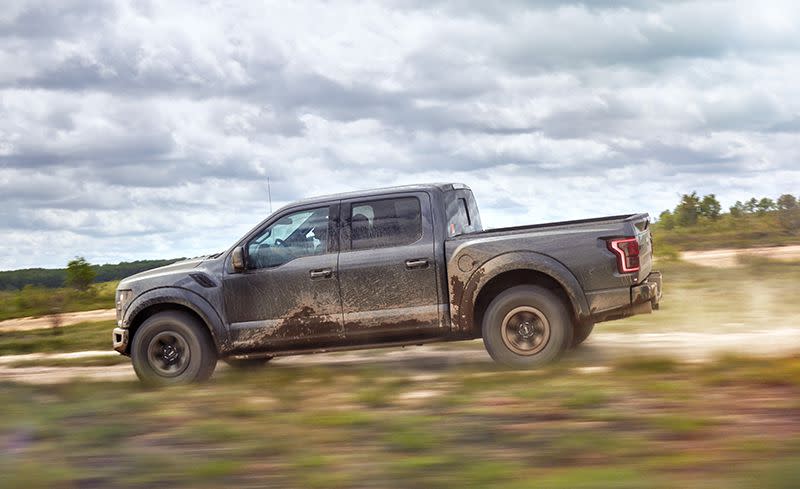2017 Ford F-150 Raptor: 40,000 Miles of Three-Ton Flying Fun
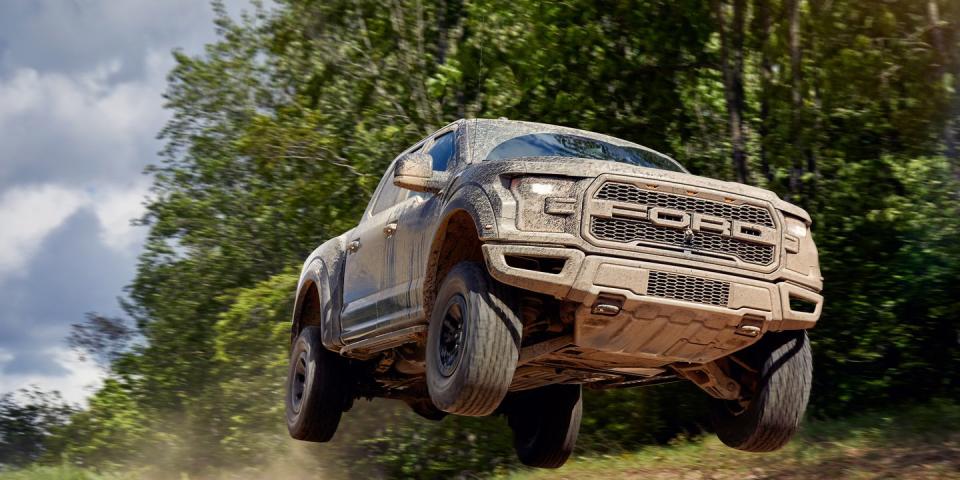
If the Ford F-150 Raptor were a geographical feature, it would have the honorific Grand before its name. Like the Grand Canyon or the Grand Teton, the Raptor is a national treasure that deserves to be billed as something substantially more significant, more consequential, more, well, grand than a mere truck. The Raptor's significance lies in how it inverts the traditional notion of the pickup, turning it from a utility vehicle into a plaything. True, trucks have been more than beasts of burden for years, growing quieter and more comfortable as they transformed into family vehicles. But the Raptor is a jumper and a dune runner that can also haul and tow and do just about everything else trucks do. Grand it is, as we discovered during the 14 months and 40,403 miles it was in our care.
Almost everyone needs a truck a few times a year. Some people even buy them for those few occasions, then tolerate their size and fuel economy for the sake of image. But the Raptor makes a strong case for ignoring its even greater size (6.4 inches wider and 1.3 inches taller than a conventional F-150 4x4 SuperCrew) and thirstiness (16 mpg versus 19 mpg combined with the lower-output 3.5-liter V-6) by balancing those burdens with virtues like, say, the ability to fly, land gracefully, and drive home. Try that in any other three-ton vehicle without wings. Its purposeful looks, which show off Fox remote-reservoir dampers under huge fenders, don't hurt, either. That it does all this without any hint of brodozer foolishness further increases its appeal.
Though its payload and tow ratings are compromised relative to a conventional F-150's, there's enough functional pickup here to suit most needs. Our Raptor's 8000-pound tow rating is 2700 pounds lower than that of the equivalent F-150 4x4 SuperCrew equipped with the 375-hp EcoBoost 3.5-liter V-6 and 10-speed automatic. The Raptor's 1200-pound payload capacity is also 830 pounds lower than that truck's. Its soft, long-travel suspension sags under the tongue weight imposed by a 5000-pound car trailer. When we towed with a bed full of spare parts and tools, its nose pointed skyward and the steering went light and loose in a way a normal F-150's wouldn't. Nose-in-the-air stance aside, the truck capably yanks around two and a half tons of weekend fun thanks to the EcoBoost's 510 pound-feet of torque and the 10-speed automatic's towing calibration. And if you're not towing all the time, maybe looking at the clouds when you do isn't a deal breaker.
Heavily outfitted, our 2017 Raptor 4x4 SuperCrew tallied $64,800 (base price $53,140). Standard equipment includes the 450-hp twin-turbocharged 3.5-liter V-6, 10-speed automatic with paddle shifters, and 4.10:1 electronically controlled locking rear differential. Our big-ticket option was the $9345 equipment group 802A, which adds the Torsen front differential, Sync 3 infotainment system, a trailer-brake controller, remote start, and more. We also opted for the $1165 17-inch forged-aluminum beadlock-capable wheels, $495 spray-in bedliner, and $375 tailgate step for easier access to that lofty bed. The heated steering wheel added $155; heated rear seats were $125.
It probably won't shock you to learn that we warmed quickly to the Raptor's torque. Sprayed with snow or gravel-the Raptor doesn't discriminate-the roads around C/D headquarters are forever scarred. But we also came to appreciate the truck's finer points. So reads the logbook: "No one does initial throttle response on a boosted engine better than Ford. Toe in just a millimeter or two and the 3.5-liter already feels awake, even before the turbos come online."
The 10-speed transmission's merits were less obvious. It faded into the background during freeway cruising and skipped multiple gears at a time during downshifts, but it inelegantly slammed home aggressive second- and third-gear shifts during around-town driving. It's not the smooth, responsive master of cog swapping that ZF's eight-speed is in a Ram. And many of us gave up using its paddle shifters in any situation short of our most aggressive driving. Even then, picking the gear that appropriately matched cornering speed was a contest among as many as three candidates. Ten is just too many for toggling gears yourself.
The Raptor's six drive modes-Normal, Sport, Weather, Mud/Sand, Baja, and Rock Crawl-do merit existence. Each mode determines things like the rear-differential setting and throttle and transmission mapping. Baja and Mud/Sand modes select high-range all-wheel drive automatically, while Rock Crawl prompts the driver to shift into low range. On its surface, the automatic shifting feels like a convenience measure, but in practice, it means the transfer case shifts with much more frequency than it might if doing so required more of the driver. Baja mode provides sufficient loosening of the reins to enjoy the Raptor's 13.0 inches of front and 13.9 inches of rear wheel travel at our western Michigan proving grounds, also known as Silver Lake Sand Dunes. It was there that one driver was moved to write: "Experiencing this thing for the first time in its element will rearrange the minds of traditional truck folk."
The Raptor also rearranged its share of gravel roads in northern Michigan, where it proved far more comfortable at speed than a 5890-pound truck should be, easily luring drivers to link gravel corners in sideways glory slides. Again, the logbook attests to the truck's potency: "If you have the nerve to forget about its considerable size and mass, this truck is planted enough to toss around like a big rally car."
At the Raptor's 10,000-mile service, the dealer noticed oil on the back of our truck's air filter. He changed the filter, and the problem-presumably a result of the positive crankcase ventilation system carrying oil into the intake-disappeared for good. We had four oil changes, which, combined with other routine maintenance and a four-wheel alignment, totaled $531. The 30,000-mile mark passed during a wet, salty February. About that time, our truck's trailer-wire plug kept shorting and causing an unrelenting instrument-cluster warning as well as an audible bong every time the short occurred. And if you're wondering how Ford deals with an issue like this-according to our dealer, it afflicted many F-150s-it's to blow compressed air into the contaminated plug and wait for drier weather to arrive, which it did. In June. In the meantime, the bonging continued.
One of the Raptor's greatest assets is its BFGoodrich All-Terrain T/A KO2 rubber, which allows it to perform off-road antics like those pictured here, adequately motivates it in the snow-we never ran winter tires because there aren't any that fit-and helps it quietly go about daily duties. Our KO2s exhibited a wide latitude of ability but were not without issues. The first problem emerged-quite literally-at around 6500 miles when the right-front tire developed a conspicuous sidewall bulge and had to be replaced at a cost of $268. We replaced all four tires due to wear at 24,284 miles at a cost of $1040, which included mounting and balancing. Another tire problem arrived just as we were wrapping up our long-term test: We found the left front to be out of round, which we blamed for a violent 40-mph vibration. We replaced both front tires for $523 before returning the truck to Ford.
In May 2017, just after completing its 1000-mile break-in period, our Raptor vaporized the 60-mph mark in 5.5 seconds and bulldozed its way through the quarter-mile in 14.2 seconds at 97 mph. By June 2018, some 39,000 miles later, it added 0.5 second to both milestones and lost 4 mph from its trap speed. In the wrap-up test, the truck needed an additional 2.5 seconds to reach 100 mph. Some of the Raptor's horsepower, it seems, had disappeared as quickly as seven BFGs and 2850 gallons of gas. Braking distance from 70 mph remained stable, stretching ever so slightly from 212 feet to 215. No one concerned themselves with the truck's initial 0.69-g and final 0.70-g lateral-acceleration numbers.
Raptors aren't easy at the pump and ours was no exception. Its most dismal fuel economy, a mere 6 mpg, came when we were bombing around the sand dunes. And when towing a fully laden 22-foot, 3500-pound snowmobile trailer to northern Michigan, it didn't do much better. With the engine running on heavy boost for much of the trip, the Raptor produced an OPEC-thrilling 8 mpg. Over the course of our loan, it averaged 14 mpg, 2 mpg below its 16-mpg EPA combined rating.
After hitting 40,000 miles, the Raptor began complaining with a noisy, ill-shifting transfer case. The dealer replaced a damaged shift fork, the clutch assembly, and a handful of other worn internal parts under warranty-a fix that took a week.
The Raptor is big, it's not as quick as it once was, and it ate a costly drivetrain part at only 40,000 miles. Its virtues don't blind us to its faults, but its dependable competence over the bulk of this test also can't be ignored, particularly considering the way the Raptor tempted us to drive. That it was fantastic in the dirt, sand, and snow will surprise no one. But its effectiveness in everyday life-even when everyday life includes spurts of gravity-defying exuberance-astonished us. It's functional enough to be both a usable truck and a pragmatic family vehicle. Perhaps the only thing it lacks is subtlety. Get yours in Magnetic Metallic like we did. No one will even notice.
Rants & Raves
Got it stuck in a car wash. Too wide-one of its few faults. -K.C. Colwell
Its real trick is being able to fit a whole family in comfort, then drive right into the dunes for a day of hard-core wheeling. -Mike Sutton
So smooth off-road. The ease with which it covers rough ground at speed is intoxicating. It takes a serious custom rig to rival its abilities. -Mike Sutton
This is the Camaro ZL1 1LE of pickups-only it works better as a daily driver than the Camaro ever could. -Rich Ceppos
The Raptor is the only new vehicle in which I aim for potholes. -Alexander Stoklosa
It got smoked in a sand drag race by a pair of Duramax brodozers running paddle tires. -Mike Sutton
Every time I climb up into the Raptor, my Fitbit thinks I've gone up a flight of stairs. -Maxwell Mortimer
Brilliant combination of ride, handling, steering, powertrain muscle and refinement, off-road chops, and comfort. Remarkable! -Rich Ceppos
From the October 2018 issue
('You Might Also Like',)

 Yahoo Autos
Yahoo Autos 